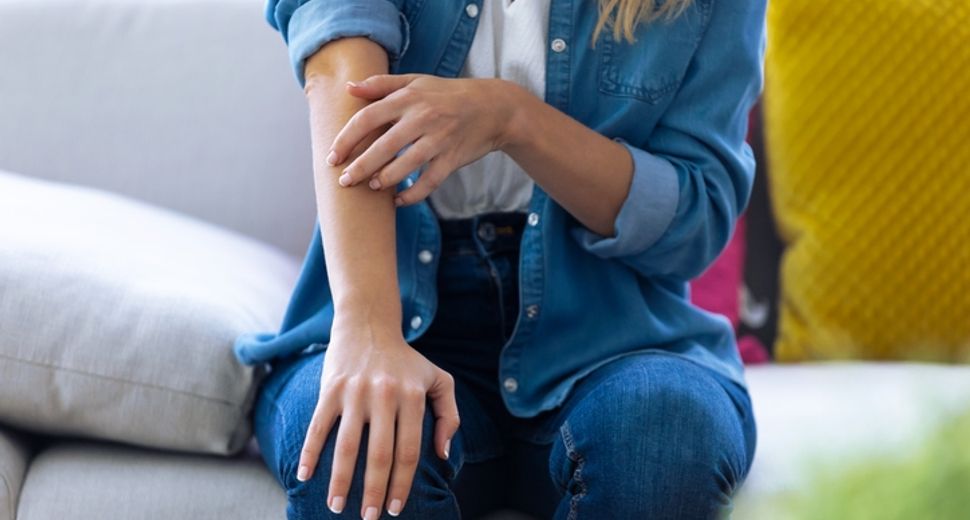The exact cause of eczema is not fully understood. Eczema is not an allergy itself, but allergies can trigger eczema. Some environmental factors (such as excessive heat or cold, scented skin products, etc.) can also trigger eczema.
Eczema most commonly causes dry, reddened skin, although the appearance of eczema varies. Intense itching is often the first symptom. Children often try to relieve the itching by rubbing or scratching the affected areas, which can make eczema worse and can eventually lead to thickened, brownish areas on the skin.
While any region of the body may be affected by eczema, it typically occurs on the face, neck, and the insides of the elbows, knees, and ankles. In infants, eczema typically occurs on the forehead, cheeks, forearms, legs, scalp, and neck.
Eczema symptoms tend to worsen and improve over time, with flare-ups occurring periodically. Although there is no cure, many children either outgrow their eczema, or it at least gets better as they get older.
What exactly is eczema?
Eczema is a chronic, recurring skin disorder characterized by dry, inflamed, and itchy skin. Unfortunately, there is no cure for eczema; however, there are many ways to control the disease by practicing good daily skin care.
What are some of the best ways to control eczema symptoms?
One of the most important parts of caring for eczema-prone skin is regular use of a moisturizer. Fragrance-free moisturizers such as CeraVe, Cetaphil, Aveeno, Eucerin, Vanicream, or Aquaphor (all available over-the-counter) are great options. Creams are more effective than lotions. Moisturizer should be applied to the skin on a daily basis, especially immediately after bathing. Choosing a gentle soap is just as important as choosing an effective moisturizer. We recommend cleansers such as Dove, CeraVe, Cetaphil, or Aveeno. Take care to use warm, rather than hot, water when bathing. When finished, gently pat the skin dry and apply moisturizer while the skin is still damp.
What are some other steps that can be taken to manage eczema?
One important tip is to avoid scratching or rubbing the skin. Keeping the fingernails short can help prevent damage due to scratching. Antihistamines, such as Benadryl, may reduce itching to a certain degree. Cool gel packs can also provide some itch relief. Wearing garments that allow air to pass freely to the skin can be helpful as well. Loose-fitting, cotton clothing is a good option. Try to avoid materials that can be irritating to the skin, such as wool. When outdoors, be sure to wear sunscreen and avoid sunburns. Find a sunscreen that is not irritating to the skin, such as a zinc oxide or titanium dioxide-based product. Do not be afraid to get in the pool – swimming provides hydration to the skin; however, be sure to take a quick shower immediately after swimming in order to remove residual chlorine or other chemicals. And, as always, apply moisturizer when finished.
Performing good daily skin care goes a long way in controlling eczema. Sometimes, though, these steps alone are not enough to manage one’s symptoms. If this is the case, schedule an appointment with a dermatologist to discuss prescription medication options. But remember, the need for prescription medication can be reduced when good skin care is practiced on a regular basis.
How to help a child with eczema
While there is no cure for eczema, you can take steps to manage your child’s symptoms and lessen the severity of outbreaks. Try to follow these suggestions:
Give your child a daily brief skin survey for any appearance of eczema.
For Infants and Toddlers, bathe daily or every other day using a cleanser only 1 – 2 times a week when actual dirt is present. Use petroleum type moisturizer (Aquaphor, Cetaphil, Cerave) ideally within 2 – 3 minutes of bathing.
For School Aged and Adolescent children), bathe/shower daily. Limit showers to 10 – 15 minutes. Use cleanser when actual dirt is present at/in neck, axillary and groin areas. Apply moisturizer or emollient creams 2 – 3 times daily, even if a bath/shower was not taken.
Avoid using scented soaps, detergents, fabric softeners, bubble bath, etc.
Avoid excessive scrubbing and toweling after bathing your child. Instead, gently pat your child’s skin dry.
Avoid dressing your child in harsh or irritating clothing, such as wool or coarsely woven materials.
Apply cool compresses (such as a wet, cool washcloth) on the irritated areas of skin to ease itching.
Keep your child’s fingernails short to minimize any skin damage caused by scratching.
Other adjuvant therapy – bleach baths: ¼ — ½ cup of household bleach added to ¾ full standard tub and soak for 5 – 10 minutes, 2 times a week.
Wet preps.


















